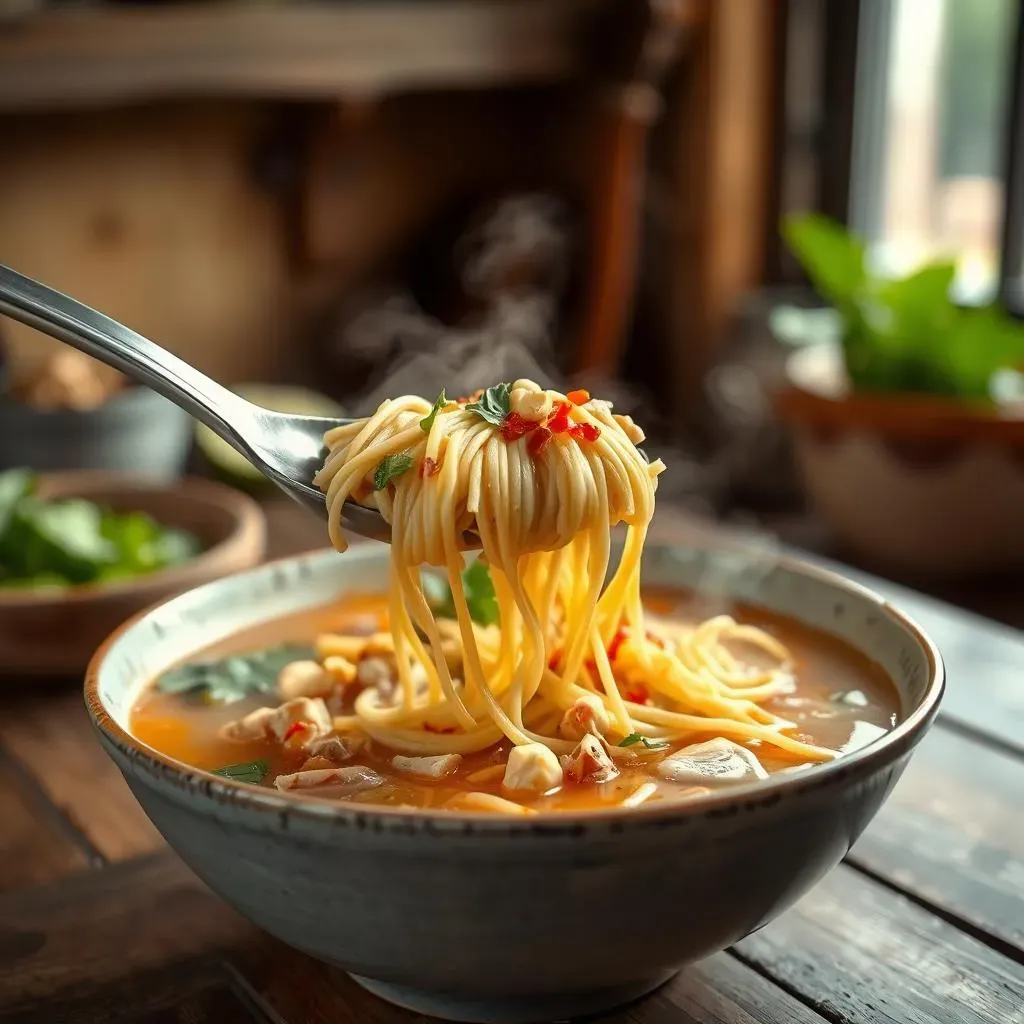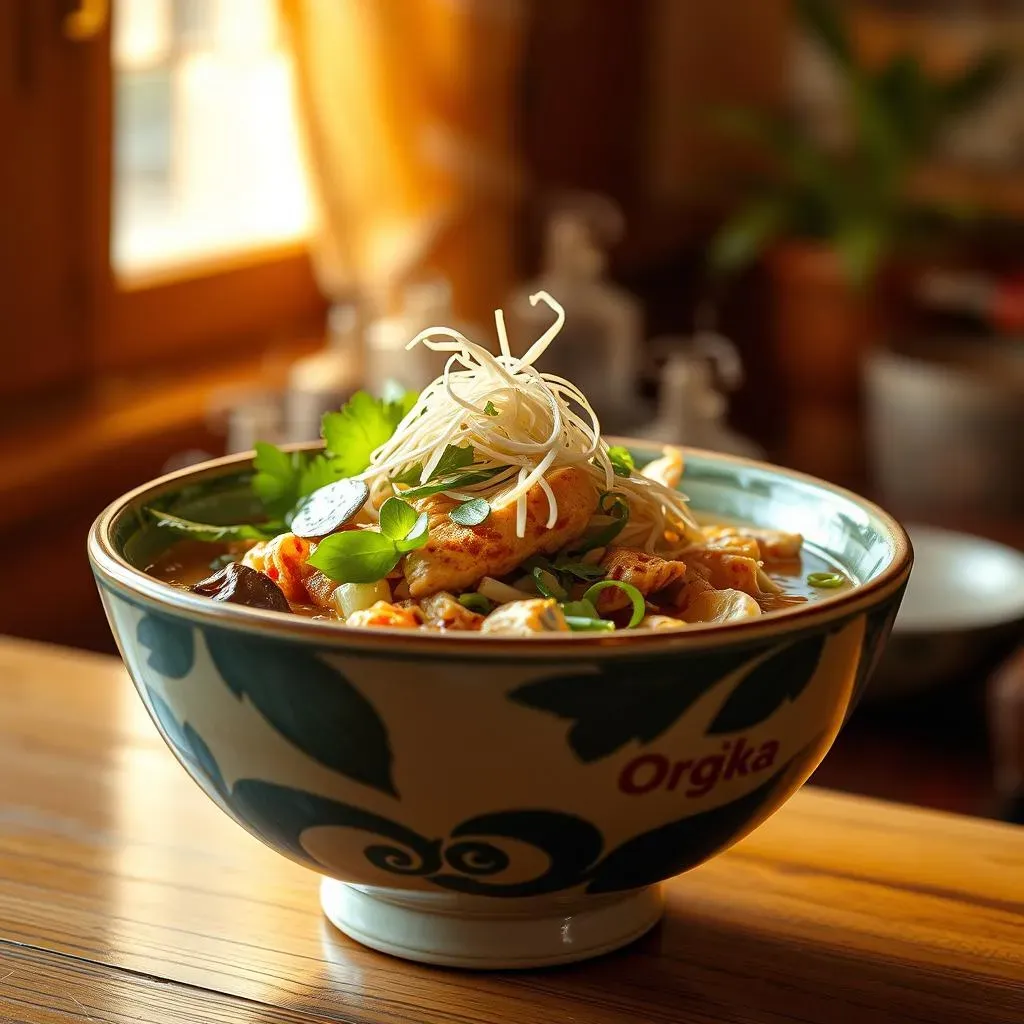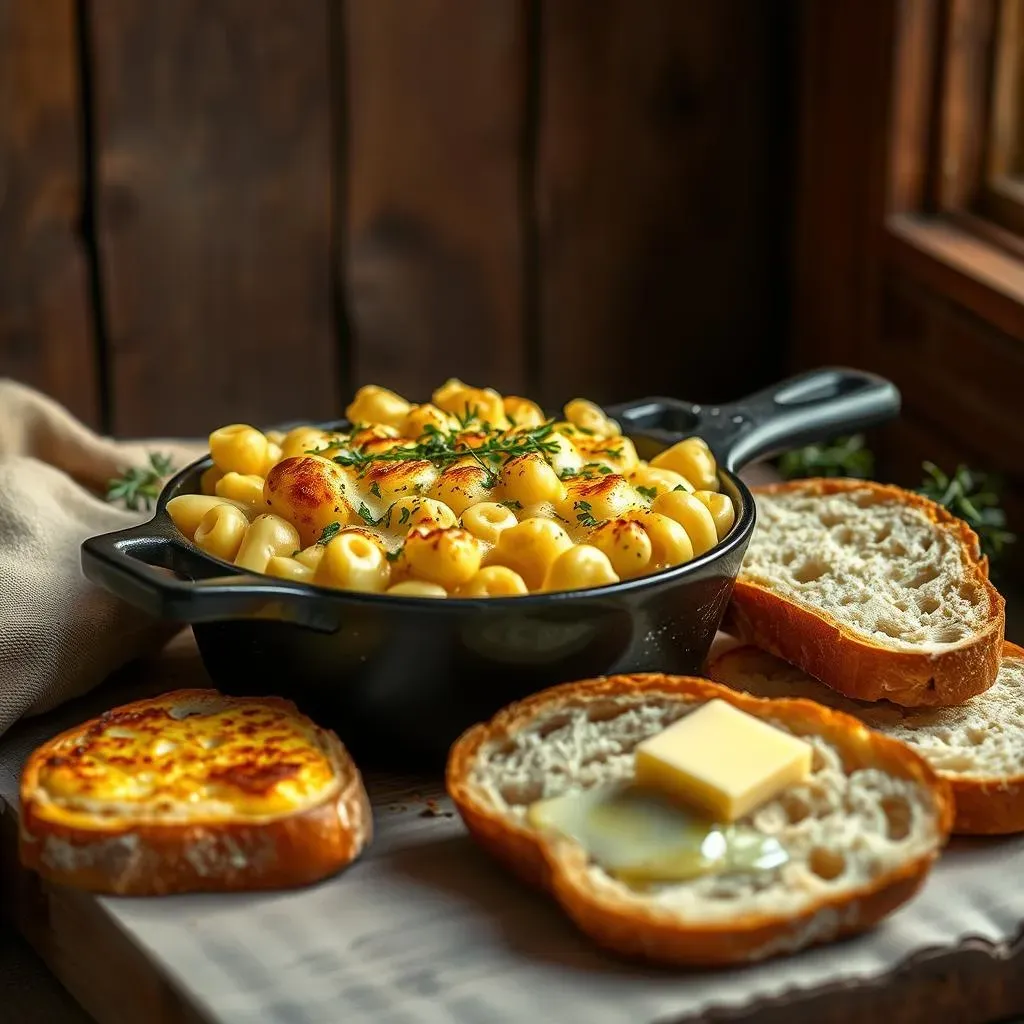Table of Contents
Are you ready for a culinary adventure that transports you straight to the bustling street food markets of Thailand? Then grab your chopsticks, because today we're diving headfirst into the vibrant world of Thai chicken noodle soup! This isn't your grandma's chicken noodle soup; this is a symphony of flavors, a fragrant explosion of coconut milk, lemongrass, and perfectly cooked noodles. Forget bland and boring – this Thai chicken noodle soup recipe is bursting with authentic taste. We'll guide you through each step, from selecting the freshest ingredients to achieving that perfect balance of sweet, sour, salty, and spicy. Whether you're a seasoned chef or a kitchen novice, this recipe is designed to be accessible and enjoyable. Get ready to learn how to craft a truly unforgettable bowl of Thai comfort food. We'll cover essential ingredients, a detailed step-by-step cooking guide, exciting variations to personalize your soup, and handy tips for storage. So, let's begin this delicious journey and unlock the secrets to the ultimate Thai chicken noodle soup recipe!
Essential Ingredients for Authentic Flavor

Essential Ingredients for Authentic Flavor
The Aromatic Base: Layering Flavors
Let's start with the foundation of any great Thai soup: the broth! For an authentic taste, you'll want to build a rich and flavorful base. Chicken broth forms the heart of the soup, but don't stop there. Fresh ginger and garlic are essential for that signature pungent aroma. A squeeze of fresh lime juice brightens everything up, adding a delightful tang. And don't forget the fish sauce – a key component of many Thai dishes, it adds a savory depth that other sauces simply can't replicate. A little goes a long way, so start with a teaspoon and adjust to your taste. For a spicier kick, add some finely chopped chilies. Remember, the beauty of Thai cooking lies in the balance of flavors!
Think of it like building a delicious lasagna – you need each layer to complement the next. The broth is your foundation, the ginger and garlic provide warmth, the lime juice adds brightness, and the fish sauce introduces umami depth. This is where the magic really happens, so don't skimp on the quality of your ingredients. Using fresh, high-quality ingredients makes all the difference in the taste of your final product. If you want a creamier broth, you can always add a splash of coconut milk later on. For more creamy chicken noodle soup ideas, check out our creamy chicken noodle soup recipe!
Ingredient | Role |
|---|---|
Chicken Broth | Base Flavor |
Ginger & Garlic | Aromatic Depth |
Lime Juice | Tartness & Brightness |
Fish Sauce | Savory Umami |
Chilies (optional) | Spice |
Noodles and Protein: The Hearty Core
Now, let's talk about the stars of the show: the noodles and the protein. For the most authentic Thai experience, you'll want to use rice noodles. They have a delicate texture that perfectly complements the rich broth. Choose thin rice noodles, as they cook quickly and soak up the flavors beautifully. When it comes to protein, chicken is the classic choice, but feel free to experiment! Shredded chicken works wonderfully, offering a tender texture that contrasts nicely with the noodles. You can also use chicken thighs for a richer, more flavorful soup. Remember to cook the chicken until it's fully cooked and tender, then shred it before adding it to the soup. It's important to make sure that the chicken is cooked thoroughly to avoid food poisoning.
While chicken is traditional, don't be afraid to branch out! Shrimp adds a delightful seafood twist. If you're a vegetarian, tofu or mushrooms make excellent substitutes. The key is to choose a protein that complements the other flavors in the soup without overpowering them. Consider the textures, too – a firmer tofu will hold its shape better in the broth than a silken variety. No matter your protein preference, ensure it's cooked thoroughly before adding it to your simmering masterpiece. Check out our vegan chicken noodle soup recipe for more inspiration!
- Rice Noodles (thin)
- Shredded Chicken (or Shrimp, Tofu, Mushrooms)
StepbyStep Cooking Guide: Mastering the Broth and Noodles

StepbyStep Cooking Guide: Mastering the Broth and Noodles
Building the Flavorful Broth
First, let's create the magic! In a large pot or Dutch oven, sauté minced garlic and ginger in a little oil until fragrant. This awakens their flavors, releasing their aromatic oils. Then, pour in your chicken broth. Bring it to a gentle simmer, allowing the flavors to meld together. This slow simmering is key – it allows the ginger and garlic to infuse the broth, creating a deep, complex flavor profile. Think of it as a slow dance between ingredients, where each one contributes its unique character to the overall harmony.
Once the broth simmers for about 15 minutes, it's time to add a splash of lime juice. This brightens the broth and balances the richness of the chicken. Now, carefully introduce your fish sauce, a teaspoon at a time, tasting as you go. Fish sauce is a powerful ingredient, adding a savory depth that's essential to Thai cuisine. Don't be afraid to experiment – the perfect amount will depend on your personal preference. For a spicier kick, add finely chopped chilies now. If you're feeling adventurous, try adding a stalk of lemongrass for an extra layer of aromatic complexity. For another flavorful option, explore our chicken noodle soup with curry flavor.
Step | Action |
|---|---|
1 | Sauté garlic and ginger |
2 | Add chicken broth, simmer |
3 | Add lime juice, fish sauce, chilies |
Perfectly Cooking the Noodles
While your broth simmers, let's tackle the noodles. Cook your thin rice noodles according to package directions. Usually, this involves boiling them in a separate pot of water until tender but still slightly firm – *al dente*, as the Italians say. Overcooked noodles will become mushy and won't hold their shape well in the soup. Undercooked noodles, on the other hand, will be unpleasant to eat. Aim for that perfect balance – a pleasant chewiness that complements the broth. Once cooked, rinse the noodles under cold water to stop the cooking process and prevent sticking. Set them aside until you're ready to assemble the soup.
Remember, cooking the noodles separately is crucial. If you add them directly to the broth, they’ll absorb too much liquid, resulting in a thick, pasty soup. Cooking them separately ensures they retain their texture and don't become soggy. Besides, it's a great way to multitask in the kitchen! While your noodles are cooking, you can focus on other aspects of the recipe, like preparing your chicken or chopping vegetables. If you want to experiment with different types of noodles, consider using egg noodles or even udon noodles for a heartier soup. For a different take on noodles, check out our spicy chicken noodle soup recipe which uses a different type of noodle!
- Boil noodles according to package directions.
- Rinse under cold water to prevent sticking.
- Set aside until ready to assemble soup.
Combining Broth, Noodles, and Protein
Now comes the exciting part – assembling your masterpiece! Gently add your shredded chicken (or chosen protein) to the simmering broth. Let it heat through, ensuring it's warmed but not overcooked. Then, add the cooked rice noodles, stirring gently to distribute them evenly throughout the broth. Simmer for another 2-3 minutes, allowing the noodles to absorb some of the flavors from the broth. This is the final touch that brings all the elements together, creating a harmonious blend of tastes and textures. Taste and adjust seasonings as needed – a final pinch of salt, a squeeze of lime, or a dash of fish sauce can make all the difference.
Serve immediately in warm bowls, garnished with fresh herbs like cilantro or basil, a squeeze of fresh lime, and a sprinkle of chopped peanuts or red pepper flakes for added crunch and flavor. Enjoy the delightful aroma and the explosion of flavors in every spoonful! This is the perfect comfort food for a chilly evening or a cozy night in. And if you have leftovers, don't worry – they're just as delicious the next day! In fact, the flavors often deepen overnight. For a similar comforting bowl, try our Chinese chicken noodle soup recipe.
"The best things in life are simple, but simple doesn't mean easy." - Unknown
Flavor Tweaks and Delicious Variations: Beyond the Basics

Flavor Tweaks and Delicious Variations: Beyond the Basics
Spice It Up!
Let's talk spice! The beauty of Thai cuisine lies in its balance of flavors, and that includes heat. Start by adding finely chopped chilies to your broth for a subtle kick. If you prefer a more intense flavor, use a Thai chili paste – just remember to start with a small amount and adjust to your preference. Different brands vary in spiciness, so it's best to add gradually. For a smoky flavor, consider adding a pinch of smoked paprika. It adds a depth that's both intriguing and delicious. Experiment and find your perfect level of heat; it’s all about personal preference!
Want to explore other spicy noodle soup options? Check out our spicy chicken noodle soup recipe for some extra inspiration. It offers a different level of spiciness and uses various spices to create a unique flavor profile. You might find some interesting ideas that you can adapt to your Thai chicken noodle soup.
- Fresh chilies (finely chopped)
- Thai chili paste
- Smoked paprika
Herby Delights and Other Additions
Fresh herbs are essential for elevating your Thai chicken noodle soup to the next level. Cilantro adds a bright, citrusy note, while basil provides a slightly peppery sweetness. Both are commonly used in Thai cooking and complement the other flavors beautifully. You can also add other vegetables like shredded carrots, sliced mushrooms, or even spinach for extra nutrients and flavor. Consider adding some bean sprouts for a nice crunch, or some chopped scallions for a fresh oniony taste. The possibilities are endless!
Don't be afraid to experiment with different combinations! Think about the textures and flavors you want to achieve. Do you prefer a creamy soup or a lighter broth? Do you want a lot of vegetables, or just a few key ingredients? The great thing about this recipe is that it's incredibly versatile – you can tailor it to your own taste preferences. For another creamy option, check out our creamy chicken noodle soup recipe. It uses coconut milk to create a rich and satisfying creamy broth.
Ingredient | Flavor Profile |
|---|---|
Cilantro | Bright, citrusy |
Basil | Slightly peppery, sweet |
Bean sprouts | Crunchy |
Scallions | Fresh, oniony |
Serving Suggestions and Storage Tips for Leftovers

Serving Suggestions and Storage Tips for Leftovers
Serving Suggestions: Elevate Your Bowl
Let's talk presentation! While this Thai chicken noodle soup is delicious on its own, a few simple garnishes can take it to the next level. Think of it as adding the finishing touches to a masterpiece. A squeeze of fresh lime juice brightens the flavors and adds a lovely tartness. Fresh herbs like cilantro and basil add a pop of color and a fragrant lift. A sprinkle of chopped peanuts provides a delightful crunch, adding both texture and flavor. For an extra kick, consider a few thinly sliced chilies. And if you're feeling fancy, a drizzle of chili oil adds a beautiful sheen and a touch of extra heat.
Consider serving your soup with a side of steamed rice or some crusty bread to soak up the delicious broth. For a more complete meal, you could serve it with a simple side salad or some spring rolls. The key is to create a balanced and satisfying dining experience. Don't be afraid to experiment with different garnishes and sides to find your perfect combination. For a different take on serving your soup, try our Mexican chicken noodle soup recipe; it offers some unique serving ideas.
Garnish | Flavor/Texture |
|---|---|
Lime wedges | Tartness, brightness |
Cilantro/Basil | Freshness, aroma |
Chopped peanuts | Crunch, nutty flavor |
Chili oil | Heat, visual appeal |
Storage Tips: Keeping Your Soup Fresh
Leftovers are a blessing, especially when it comes to this incredibly flavorful soup! To ensure your Thai chicken noodle soup remains delicious for days to come, proper storage is key. Allow the soup to cool completely before storing it in an airtight container. This prevents the growth of harmful bacteria. Store it in the refrigerator for up to three days. Any longer, and the flavors might start to fade, and the texture might change. When reheating, gently warm the soup on the stovetop or in the microwave, avoiding vigorous boiling, which can damage the delicate flavors.
Freezing your leftover soup is also a great option. Pour the cooled soup into freezer-safe containers, leaving some headspace for expansion. Frozen soup can last for up to three months. When ready to enjoy, thaw overnight in the refrigerator and reheat gently. Freezing and reheating might slightly alter the texture, but the flavors will remain largely intact. Freezing is particularly useful if you've made a large batch and want to enjoy it over several weeks. If you're looking for other ways to use leftovers, try adding them to a stir-fry or using them as a base for another dish. For more storage tips, check out our dairy-free chicken noodle soup recipe which also provides extensive storage tips.
- Cool completely before storing.
- Refrigerate for up to 3 days.
- Freeze for up to 3 months.
- Reheat gently.
Reheating and Serving Leftovers
Reheating your Thai chicken noodle soup is a breeze! For the best results, gently warm the soup on the stovetop over low heat. Avoid boiling, as this can make the broth watery and affect the delicate flavors. Alternatively, you can reheat it in the microwave, but be mindful of splattering. If using the microwave, heat in short bursts, stirring in between, to ensure even heating. Once reheated, taste and adjust the seasoning as needed; a squeeze of fresh lime or a dash of fish sauce might enhance the flavors after sitting in the fridge.
When serving leftovers, consider adding some fresh garnishes to brighten the flavors and add some visual appeal. A sprinkle of chopped cilantro or a few slices of fresh chili can make a big difference. You can also add a spoonful of your favorite chili sauce or a dollop of sriracha for an extra kick. Remember, the beauty of this recipe lies in its adaptability – feel free to customize it to your liking. Enjoy your delicious, reheated Thai chicken noodle soup! For another flavorful soup that reheats well, try our chicken noodle soup with ginger and garlic.
"A little bit of what you fancy does you good." - Old English Proverb
